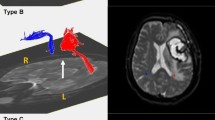Abstract
Primary progressive aphasia (PPA) is defined as progressive decline in language for 2 or more years with preservation of activities of daily living and general cognitive functions. Whereas the clinical features of this syndrome have been well documented, the neuroradiological findings have not been studied systematically. We studied 13 patients with PPA retrospectively: 10 underwent CT, 12 MRI and 12 cerebral perfusion studies using99mTc-HMPAO SPECT. CT and MR images were scored for focal atrophy by two independent assessors. Initial qualitative assessment of SPECT images was confirmed by quantitative analysis. CT was normal in 5 patients. Focal atrophy, affecting predominantly the left temporal lobe, was seen in 4 of 10 patients on CT, and 10 of 12 on MRI. Atrophy was localised primarily to the superior and middle temporal gyri on MRI. All 12 patients who underwent SPECT had unilateral temporal lobe perfusion defects, in 2 patients of whom MRI was normal. CT is relatively insensitive to focal abnormalities in PPA; MRI and SPECT are the imaging modalities of choice. MRI allows accurate, specific localisation of atrophy within the temporal neocortex. SPECT may reveal a functional decrease in cerebral perfusion prior to establishment of structural change.
Similar content being viewed by others
References
Mesulam M-M (1982) Slowly progressive aphasia without generalised dementia. Ann Neurol 11:592–598
HOdges JR (1994) Pick's disease. In: Burns A, Levy R (eds) Dementia. Chapman and Hall, London, pp 739–753
Weintraub S, Rubin NP, Mesulam M-M (1990) Primary progressive aphasia: longitudinal course, neuropsychological profile and language features. Arch Neurol 47:1329–1335
Snowden JS, Neary D, Mann DMA, Goulding PJ, Testa HJ (1992) Progressive language disorder due to lobar atrophy. Ann Neurol 31:174–183
Hodges JR, Patterson K, Oxbury S, Funnell E (1992) Semantic dementiaprogressive fluent aphasia with temporal lobe atrophy. Brain 115:1783–1806
Kempler D, Metter EJ, Riege WH, Jackson CA, Benson DF, Hanson WR (1990) Slowly progressiva aphasia: three cases with language, memory, CT and PET data. J Neurol Neurosurg Psychiatry 53:987–993
Tyrell PJ, Warrington EK, Frackowiak RSJ, Rossor MN (1990) Heterogeneity in progressive aphasia due to focal cortical atrophy: a clinical and PET study. Brain 113:1321–1336
Duffy JR, Petersen RC (1992) Primary progressive aphasia. Aphasiology 6:1–15
Binder GA, Haughton VM, Ho K-C (1979) Computed tomography of the brain in axial, coronal and sagittal planes. Little, Brown, Boston
Eagger S, Syed GMS, Burns A, Barrett JJ, Jevy R (1992) Morphologic (CT) and functional (rCBF-SPECT) correlates in Alzheimer's disease. Nucl Med Commun 13:644–647
Mesulam MM (1987) Primary progressive aphasia-differentiation from Alzheimer's disease. Ann Neurol 22: 533–534
Kirshner HS, Tanridag O, Thurman L, Whetsell WO (1987) Progressive aphasia without dementia: two cases with focal spongiform degeneration. Ann Neurol 22:527–532
Neary D, Snowden JS, Mann DMA (1993) The clinical pathological correlates of lobar atrophy. Dementia 4:154–159
Scheltens P, Ravid R, Kamphorst W (1994) Pathological findings in a case of primary progressive aphasia. Neurology 44:279–282
Wechsler AF, Verity MA, Rosenschien S, Fried I, Scheibel AB (1982) Pick's disease: a clinical, computed tomographic and histologic study with Golgi impregnation observations. Arch Neurol 39:287–290
Holland AL, McBurney DH, Moossy J, Reinmuth OM (1985) The dissolution of language in Pick's disease with neurofibrillary tangles: a case study. Brain Lang 24:36–58
Kesslak JP, Nalcioglu O, Cotman CW (1991) Quantification of magnetic resonance scan for hippocampal and parahippocampal atrophy in Alzheimer's disease. Neurology 41:51–54
Jack CR, Petersen RC, O'Brien PC, Tangalos EG (1992) MR-based hippocampal volumetry in the diagnosis of Alzheimer's disease. Neurology 42: 183–188
Caselli RJ, Jack CR, Petersen RC, Wahner HW, Yanagihara T (1992) Asymmetric cortical degenerative syndromes: clinical and radiologic correlations. Neurology 42:1462–1468
Gemmell H, Sharp P, Besson J, et al (1987) Differential diagnosis in dementia using cerebral blood flow agent99mTc HMPAO, a new cerebral blood flow agent. J Comput Assist Tomogr 11:398–402
Neary D, Snowden JS, Shields RA, et al (1987) Single photon emission tomography using99mTc HMPAO in the investigation of dementia. J Neurol Neurosurg Psychiatry 50:1101–1109
Syed GMS, Eagger S, O'Brien J, Barrett JJ, Levy R (1992) Patterns of regional cerebral blood flow in Alzheimer's disease. Nucl Med Commun 13:656–663
Author information
Authors and Affiliations
Rights and permissions
About this article
Cite this article
Sinnatamby, R., Antoun, N.A., Freer, C.E.L. et al. Neuroradiological findings in primary progressive aphasia: CT, MRI and cerebral perfusion SPECT. Neuroradiology 38, 232–238 (1996). https://doi.org/10.1007/BF00596535
Received:
Accepted:
Issue Date:
DOI: https://doi.org/10.1007/BF00596535




